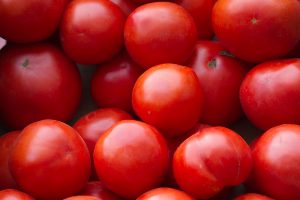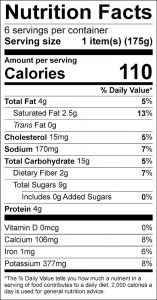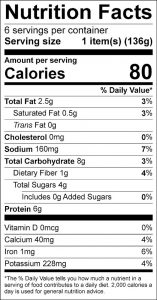Bulletin #4178, Vegetables and Fruits for Health: Tomatoes

Revised and updated by Associate Extension Professor Kathleen Savoie and Statewide Nutrition and Physical Activity Educator Kate Yerxa, University of Maine Cooperative Extension.
Originally developed by Extension Nutrition Specialist Nellie Hedstrom, University of Maine Cooperative Extension.
For information about UMaine Extension programs and resources, visit extension.umaine.edu.
Find more of our publications and books at extension.umaine.edu/publications/.
Nutrition Information
There is nothing like a Maine-grown tomato during summer! From mid-July to late September, Maine residents can enjoy the freshness and flavor of locally grown tomatoes picked at peak ripeness. Though technically a fruit, the tomato is treated as a vegetable. Originally tomatoes were yellow, but today most of those produced in the United States are red. In addition to the standard-sized, round tomatoes, there are other varieties, such as plum, pear-shaped, and cherry tomatoes.
Tomatoes are rich in vitamins A and C and fiber, and are cholesterol free. Field- or vine-ripened tomatoes available in summer are higher in vitamin C than the greenhouse tomatoes that are available in fall and winter. Fresh tomatoes contain more vitamin C than cooked or canned. Tomatoes contain lycopene, an important carotenoid, which may help protect against prostate cancer and heart disease.
Selection
Select firm, fragrant fruit with full, bright color. Avoid bruised, blemished, soft, or hard fruit. Tomatoes should yield to gentle pressure.
Storage
Keep ripe tomatoes at room temperature: above 55 degrees is recommended. Do not refrigerate under-ripe fruit. Tomatoes will ripen better out of sunlight. Once tomatoes are red and slightly soft, they will keep a day or two at room temperature. Refrigerate only if you want to keep them longer.
Preparation
Wash carefully. Peel if you desire. To peel, remove stem core and dip tomatoes in a large quantity of boiling water for 30 seconds; then dip in cold water, and the skins will be easy to remove. When using tomato pulp in a recipe, it is a good idea to remove the skin and seeds first, as they toughen when cooked.
Raw: This is the best way to enjoy a freshly picked tomato! Add fresh tomatoes to salads, nachos, scrambled eggs, sandwiches, or macaroni and cheese. You can even make an uncooked tomato sauce. Peel and seed a tomato, mash it into a pulp, and add minced onions, a little red wine vinegar, and chopped herbs. Or try chilled or hot fresh tomato soup—the canned variety doesn’t compare!
Broil: Halve large tomatoes, sprinkle with pepper and a little oil, or try parmesan cheese and oregano. Cook four to five minutes under the broiler at 500 degrees until heated through. These are excellent served as a side dish.
Bake: Bake tomato halves, either plain or stuffed with toppings, in a 400°F oven for eight to fifteen minutes.
Microwave: Cook in a covered dish. One pound will take three to four minutes. Use in casseroles, stews, soups, and sauces.
Stuffed Tomatoes
Serves 6
6 medium tomatoes
1/2 cup couscous
1/4 cup boiling vegetable (or chicken) stock
3 1/2 ounces feta cheese
1 tablespoon balsamic vinegar
1/4 cup raisins
1 teaspoon dried mint
1 teaspoon dried basil
Cut tops off tomatoes (reserve tops) and scoop out flesh. Place tomatoes on a lined baking tray. Chop flesh and place in bowl. Add couscous and stock to the tomato flesh. Stir in feta, vinegar, herbs and raisins. Spoon couscous mixture into the tomato shells, place tops back on and bake at 350°F for 15–20 minutes. Serve hot.
Broiled Tomatoes and Cheese
Serves 6
3 large tomatoes, cut in half
1/2 pound low-fat cottage cheese
1/2 teaspoon basil
1/8 teaspoon black pepper
1/4 cup plain bread crumbs
1 tablespoon margarine
Mix cottage cheese, basil, and pepper and spread onto tomato halves. Sprinkle with crumbs. Dot with margarine. Broil about 10 minutes on lightly greased broiler pan.
Some content adapted with permission from University of Massachusetts Cooperative Extension.
Information in this publication is provided purely for educational purposes. No responsibility is assumed for any problems associated with the use of products or services mentioned. No endorsement of products or companies is intended, nor is criticism of unnamed products or companies implied.
© 2009
Call 800.287.0274 (in Maine), or 207.581.3188, for information on publications and program offerings from University of Maine Cooperative Extension, or visit extension.umaine.edu.
In complying with the letter and spirit of applicable laws and pursuing its own goals of diversity, the University of Maine System does not discriminate on the grounds of race, color, religion, sex, sexual orientation, transgender status, gender, gender identity or expression, ethnicity, national origin, citizenship status, familial status, ancestry, age, disability physical or mental, genetic information, or veterans or military status in employment, education, and all other programs and activities. The University provides reasonable accommodations to qualified individuals with disabilities upon request. The following person has been designated to handle inquiries regarding non-discrimination policies: Director of Equal Opportunity and Title IX Services, 5713 Chadbourne Hall, Room 412, University of Maine, Orono, ME 04469-5713, 207.581.1226, TTY 711 (Maine Relay System).



